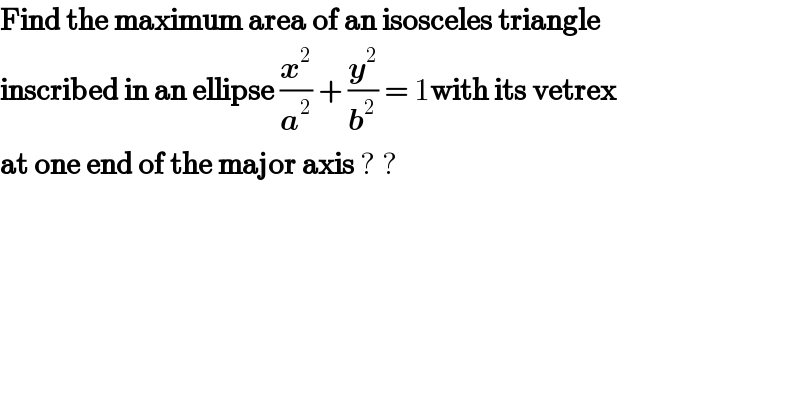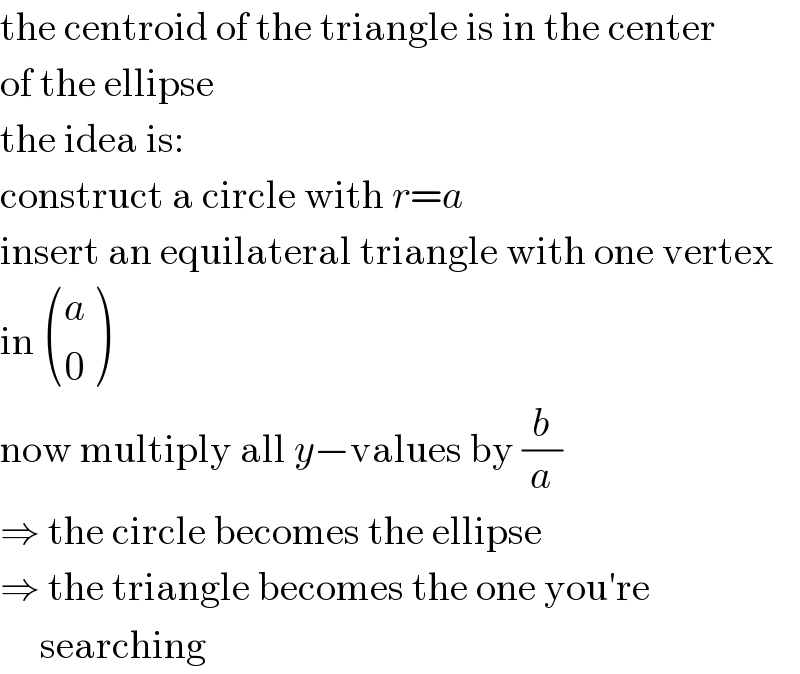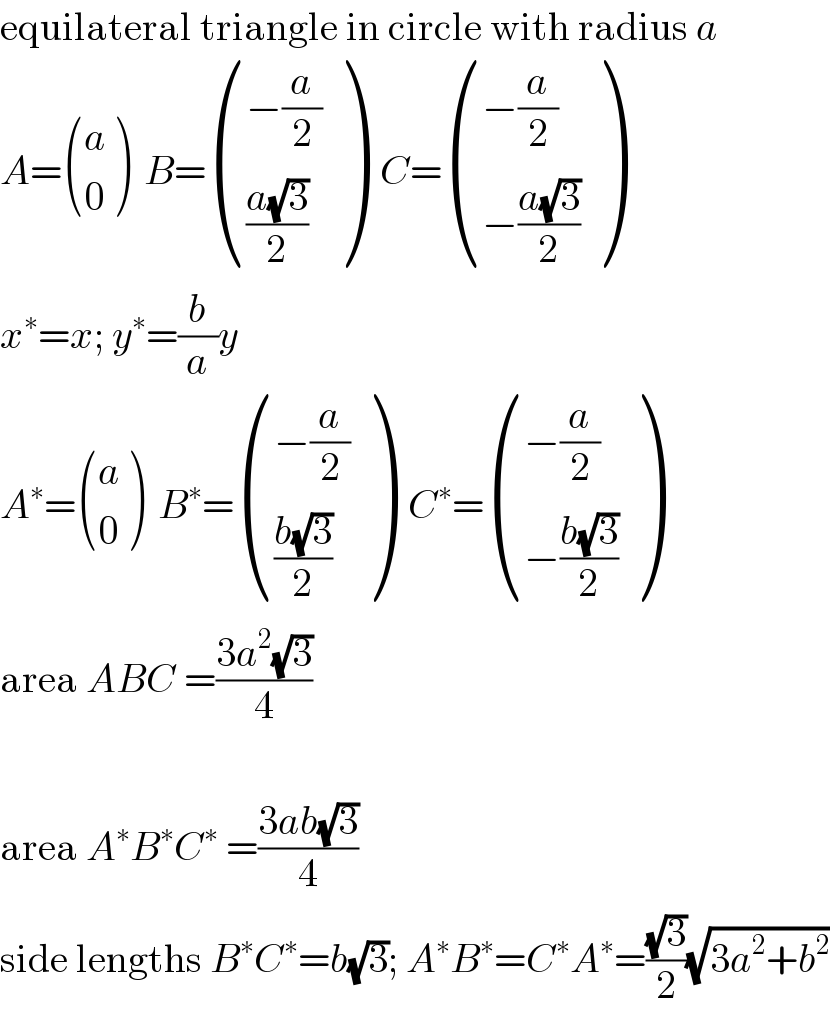
Question Number 76077 by vishalbhardwaj last updated on 23/Dec/19

$$\boldsymbol{\mathrm{Find}}\:\boldsymbol{\mathrm{the}}\:\boldsymbol{\mathrm{maximum}}\:\boldsymbol{\mathrm{area}}\:\boldsymbol{\mathrm{of}}\:\boldsymbol{\mathrm{an}}\:\boldsymbol{\mathrm{isosceles}}\:\boldsymbol{\mathrm{triangle}} \\ $$$$\boldsymbol{\mathrm{inscribed}}\:\boldsymbol{\mathrm{in}}\:\boldsymbol{\mathrm{an}}\:\boldsymbol{\mathrm{ellipse}}\:\frac{\boldsymbol{{x}}^{\mathrm{2}} }{\boldsymbol{{a}}^{\mathrm{2}} }\:+\:\frac{\boldsymbol{{y}}^{\mathrm{2}} }{\boldsymbol{{b}}^{\mathrm{2}} }\:=\:\mathrm{1}\boldsymbol{\mathrm{with}}\:\boldsymbol{\mathrm{its}}\:\boldsymbol{\mathrm{vetrex}}\: \\ $$$$\boldsymbol{\mathrm{at}}\:\boldsymbol{\mathrm{one}}\:\boldsymbol{\mathrm{end}}\:\boldsymbol{\mathrm{of}}\:\boldsymbol{\mathrm{the}}\:\boldsymbol{\mathrm{major}}\:\boldsymbol{\mathrm{axis}}\:?\:? \\ $$
Commented by MJS last updated on 23/Dec/19

$$\mathrm{the}\:\mathrm{centroid}\:\mathrm{of}\:\mathrm{the}\:\mathrm{triangle}\:\mathrm{is}\:\mathrm{in}\:\mathrm{the}\:\mathrm{center} \\ $$$$\mathrm{of}\:\mathrm{the}\:\mathrm{ellipse} \\ $$$$\mathrm{the}\:\mathrm{idea}\:\mathrm{is}: \\ $$$$\mathrm{construct}\:\mathrm{a}\:\mathrm{circle}\:\mathrm{with}\:{r}={a} \\ $$$$\mathrm{insert}\:\mathrm{an}\:\mathrm{equilateral}\:\mathrm{triangle}\:\mathrm{with}\:\mathrm{one}\:\mathrm{vertex} \\ $$$$\mathrm{in}\:\begin{pmatrix}{{a}}\\{\mathrm{0}}\end{pmatrix} \\ $$$$\mathrm{now}\:\mathrm{multiply}\:\mathrm{all}\:{y}−\mathrm{values}\:\mathrm{by}\:\frac{{b}}{{a}} \\ $$$$\Rightarrow\:\mathrm{the}\:\mathrm{circle}\:\mathrm{becomes}\:\mathrm{the}\:\mathrm{ellipse} \\ $$$$\Rightarrow\:\mathrm{the}\:\mathrm{triangle}\:\mathrm{becomes}\:\mathrm{the}\:\mathrm{one}\:\mathrm{you}'\mathrm{re} \\ $$$$\:\:\:\:\:\mathrm{searching} \\ $$
Commented by MJS last updated on 23/Dec/19

$$\mathrm{btw}\:\mathrm{all}\:\mathrm{triangles}\:\mathrm{you}\:\mathrm{construct}\:\mathrm{this}\:\mathrm{way}, \\ $$$$\mathrm{out}\:\mathrm{of}\:\mathrm{an}\:\mathrm{equilateral}\:\mathrm{triangle},\:\mathrm{no}\:\mathrm{matter} \\ $$$$\mathrm{where}\:\mathrm{you}\:\mathrm{put}\:\mathrm{the}\:\mathrm{vertices}\:\mathrm{on}\:\mathrm{the}\:\mathrm{circle} \\ $$$$\mathrm{will}\:\mathrm{share}\:\mathrm{the}\:\mathrm{same}\:\mathrm{maximum}\:\mathrm{area} \\ $$
Commented by vishalbhardwaj last updated on 23/Dec/19

$$\mathrm{sir}\:\mathrm{can}\:\mathrm{you}\:\mathrm{give}\:\mathrm{a}\:\mathrm{formate}\:\mathrm{of}\:\mathrm{solution}\:\mathrm{regarding}\:\mathrm{this} \\ $$
Answered by MJS last updated on 23/Dec/19

$$\mathrm{equilateral}\:\mathrm{triangle}\:\mathrm{in}\:\mathrm{circle}\:\mathrm{with}\:\mathrm{radius}\:{a}\: \\ $$$${A}=\begin{pmatrix}{{a}}\\{\mathrm{0}}\end{pmatrix}\:\:{B}=\begin{pmatrix}{−\frac{{a}}{\mathrm{2}}}\\{\frac{{a}\sqrt{\mathrm{3}}}{\mathrm{2}}}\end{pmatrix}\:\:{C}=\begin{pmatrix}{−\frac{{a}}{\mathrm{2}}}\\{−\frac{{a}\sqrt{\mathrm{3}}}{\mathrm{2}}}\end{pmatrix} \\ $$$${x}^{\ast} ={x};\:{y}^{\ast} =\frac{{b}}{{a}}{y} \\ $$$${A}^{\ast} =\begin{pmatrix}{{a}}\\{\mathrm{0}}\end{pmatrix}\:\:{B}^{\ast} =\begin{pmatrix}{−\frac{{a}}{\mathrm{2}}}\\{\frac{{b}\sqrt{\mathrm{3}}}{\mathrm{2}}}\end{pmatrix}\:\:{C}^{\ast} =\begin{pmatrix}{−\frac{{a}}{\mathrm{2}}}\\{−\frac{{b}\sqrt{\mathrm{3}}}{\mathrm{2}}}\end{pmatrix} \\ $$$$\mathrm{area}\:{ABC}\:=\frac{\mathrm{3}{a}^{\mathrm{2}} \sqrt{\mathrm{3}}}{\mathrm{4}} \\ $$$$ \\ $$$$\mathrm{area}\:{A}^{\ast} {B}^{\ast} {C}^{\ast} \:=\frac{\mathrm{3}{ab}\sqrt{\mathrm{3}}}{\mathrm{4}} \\ $$$$\mathrm{side}\:\mathrm{lengths}\:{B}^{\ast} {C}^{\ast} ={b}\sqrt{\mathrm{3}};\:{A}^{\ast} {B}^{\ast} ={C}^{\ast} {A}^{\ast} =\frac{\sqrt{\mathrm{3}}}{\mathrm{2}}\sqrt{\mathrm{3}{a}^{\mathrm{2}} +{b}^{\mathrm{2}} } \\ $$
Commented by vishalbhardwaj last updated on 23/Dec/19

$$\mathrm{Dear}\:\mathrm{sir},\:\mathrm{can}\:\mathrm{we}\:\mathrm{solve}\:\mathrm{this}\:\mathrm{question}\:\mathrm{by}\:\mathrm{using}\: \\ $$$$\mathrm{differentiation}\left(\mathrm{maxima}\:\mathrm{and}\:\mathrm{minima}\:\mathrm{condition}\right) \\ $$$$ \\ $$$$ \\ $$
Answered by MJS last updated on 23/Dec/19
![A= ((a),(0) ) B= ((x),(((b/a)(√(a^2 −x^2 )))) ) C= ((x),((−(b/a)(√(a^2 −x^2 )))) ) ∣AB∣^2 =∣CA∣^2 =(x−a)(x−((a(a^2 +b^2 ))/(a^2 −b^2 ))) ∣BC∣^2 =((4b^2 )/a^2 )(a^2 −x^2 ) area (o, p, q) = =(1/4)(√((o+p+q)(−o+p+q)(o−p+q)(o+p−q))) =(1/4)(√(2(o^2 p^2 +o^2 q^2 +p^2 q^2 −(o^4 +p^4 +q^4 ))) area (o, p, p) =(1/4)o(√(4p^2 −o^2 )) o^2 =((4b^2 )/a^2 )(a^2 −x^2 )∧p^2 =(x−a)(x−((a(a^2 +b^2 ))/(a^2 −b^2 ))) area (o, p, p) =(b/a)∣x−a∣(√(a^2 −x^2 )) (d/dx)[(b/a)∣x−a∣(√(a^2 −x^2 ))]=±((b(2x^2 −ax−a^2 ))/(a(√(a^2 −x^3 ))))=0 ⇒ x=−(a/2)](Q76089.png)
$${A}=\begin{pmatrix}{{a}}\\{\mathrm{0}}\end{pmatrix}\:\:{B}=\begin{pmatrix}{{x}}\\{\frac{{b}}{{a}}\sqrt{{a}^{\mathrm{2}} −{x}^{\mathrm{2}} }}\end{pmatrix}\:\:{C}=\begin{pmatrix}{{x}}\\{−\frac{{b}}{{a}}\sqrt{{a}^{\mathrm{2}} −{x}^{\mathrm{2}} }}\end{pmatrix} \\ $$$$\mid{AB}\mid^{\mathrm{2}} =\mid{CA}\mid^{\mathrm{2}} =\left({x}−{a}\right)\left({x}−\frac{{a}\left({a}^{\mathrm{2}} +{b}^{\mathrm{2}} \right)}{{a}^{\mathrm{2}} −{b}^{\mathrm{2}} }\right) \\ $$$$\mid{BC}\mid^{\mathrm{2}} =\frac{\mathrm{4}{b}^{\mathrm{2}} }{{a}^{\mathrm{2}} }\left({a}^{\mathrm{2}} −{x}^{\mathrm{2}} \right) \\ $$$$\mathrm{area}\:\left({o},\:{p},\:{q}\right)\:= \\ $$$$=\frac{\mathrm{1}}{\mathrm{4}}\sqrt{\left({o}+{p}+{q}\right)\left(−{o}+{p}+{q}\right)\left({o}−{p}+{q}\right)\left({o}+{p}−{q}\right)} \\ $$$$=\frac{\mathrm{1}}{\mathrm{4}}\sqrt{\mathrm{2}\left({o}^{\mathrm{2}} {p}^{\mathrm{2}} +{o}^{\mathrm{2}} {q}^{\mathrm{2}} +{p}^{\mathrm{2}} {q}^{\mathrm{2}} −\left({o}^{\mathrm{4}} +{p}^{\mathrm{4}} +{q}^{\mathrm{4}} \right)\right.} \\ $$$$\mathrm{area}\:\left({o},\:{p},\:{p}\right)\:=\frac{\mathrm{1}}{\mathrm{4}}{o}\sqrt{\mathrm{4}{p}^{\mathrm{2}} −{o}^{\mathrm{2}} } \\ $$$${o}^{\mathrm{2}} =\frac{\mathrm{4}{b}^{\mathrm{2}} }{{a}^{\mathrm{2}} }\left({a}^{\mathrm{2}} −{x}^{\mathrm{2}} \right)\wedge{p}^{\mathrm{2}} =\left({x}−{a}\right)\left({x}−\frac{{a}\left({a}^{\mathrm{2}} +{b}^{\mathrm{2}} \right)}{{a}^{\mathrm{2}} −{b}^{\mathrm{2}} }\right) \\ $$$$\mathrm{area}\:\left({o},\:{p},\:{p}\right)\:=\frac{{b}}{{a}}\mid{x}−{a}\mid\sqrt{{a}^{\mathrm{2}} −{x}^{\mathrm{2}} } \\ $$$$\frac{{d}}{{dx}}\left[\frac{{b}}{{a}}\mid{x}−{a}\mid\sqrt{{a}^{\mathrm{2}} −{x}^{\mathrm{2}} }\right]=\pm\frac{{b}\left(\mathrm{2}{x}^{\mathrm{2}} −{ax}−{a}^{\mathrm{2}} \right)}{{a}\sqrt{{a}^{\mathrm{2}} −{x}^{\mathrm{3}} }}=\mathrm{0} \\ $$$$\Rightarrow\:{x}=−\frac{{a}}{\mathrm{2}} \\ $$
